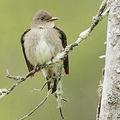 在全球已確知的油田中,加拿大的油砂礦(tar sands)蘊藏量僅次於沙烏地阿拉伯,然而最新研究顯示,在加拿大北部寒帶森林開採油砂礦,將破壞森林與濕地等棲地。在這篇經過科學家互相審核的報告裡預測,發展油砂礦業可能導致寒帶森林的鳥類死亡,總數超過1億6千萬隻。
在全球已確知的油田中,加拿大的油砂礦(tar sands)蘊藏量僅次於沙烏地阿拉伯,然而最新研究顯示,在加拿大北部寒帶森林開採油砂礦,將破壞森林與濕地等棲地。在這篇經過科學家互相審核的報告裡預測,發展油砂礦業可能導致寒帶森林的鳥類死亡,總數超過1億6千萬隻。
此報告是數個單位聯合進行研究後的成果,包括了橫跨加拿大的非營利研究組織「潘比納研究所」(Pembina Institute)、西雅圖的「寒帶鳴禽行動組織」(Boreal Songbird Initiative)、「自然資源保衛委員會」(Natural Resources Defense Council),以及美國的研究及保育提倡團體。
在這份《生育地危機》(Danger in the Nursery)報告中提到,在亞伯達省東北部的油砂開採活動,全球大型石油公司幾乎全部都有參與,而這個區域至少提供了292種鳥類繁殖。
美洲常見的許多鳴禽及水鳥都在寒帶森林這個「鳥類生育地」進行繁殖,而且已經出現數量減少的問題,除了開採油砂帶來的威脅,伐木以及遷徙停留定點環境惡化也都是原因。
露天開採(strip mining)油砂礦必須先在礦場將湖泊與濕地放乾,讓河川溪流轉向,並且把森林完全伐去,移除所有的植物。接著使用油壓挖土機(hydraulic shovels)與卡車進行開挖,深度達100公尺。
報告首席作者是寒帶鳴禽行動組織的資深科學家威爾斯博士(Jeff Wells)。他表示,「露天採礦預計將摧毀30萬公頃的寒帶森林及濕地。」
他也指出,「目前已知的油砂礦藏有80%以上位在深處,用露天採礦無法探取,必須改以『就地鑽探法』(in-situ drilling)進行開採,這需要密集的道路、管線、壓縮站與發電設備,最後破壞的棲地會比露天採礦還多。」
全球受威脅的鳥種包括銹色黑鸝(rusty blackbird, Euphagus carolinus)與斯普拉格氏鹨(Sprague's pipit, Anthus spragueii),兩種都是「易危」(vulnerable)等級,另外還有「近危」(Near Threatened)等級的橄欖脅綠霸鶲 (olive-sided flycatcher, Contopus cooperi)。
而瀕危的美洲鶴(whooping crane, Grus americana)在野外僅存一個遷徙族群,就在北邊的伍德布法羅國家公園(Wood Buffalo National Park)築巢,遷徙時會經過油砂礦區,偶爾還會在寒帶濕地中停歇。
美國奧杜邦學會(National Audubon Society)的全球重要鳥類保護區(IBA)計畫主任西錫(John Cecil)表示,「對新熱帶地區候鳥(neotropical migrant)而言,加拿大的寒帶森林是極度重要的繁殖區域。這份報告詳細指出各種影響,其中至少有5個IBA受到威脅。」
「油砂」這種高黏度石油是混合了沙、黏土與水的天然瀝青(bitumen)。開採提煉油砂以及後續合成製造重油產品的過程,會產生溫室氣體污染。每製造一桶合成重油的溫室氣體排放量,是每桶傳統石油的3倍。
開採油砂留下的廢水池裝滿許多有毒的採礦廢棄物,對遷徙的水鳥造成嚴重危險,因為這些池塘不像其他天然水體會在冬季結凍。2008年4月,亞伯達省北部有500隻鴨子在降落於油砂礦附近的廢水池之後死亡。
潘比納研究所的戴爾(Simon Dyer)是報告的作者之一,他表示,「這份報告再一次對亞伯達省政府的發出警訊,因為它證實了發展油砂採礦所累積的衝擊,是在一條不永續的道路上。」
戴爾也說,「油砂採礦與當地建設已經顯著造成寒帶森林鳥類死亡。亞伯達省必須儘速採取長期保育計畫與政策,化解這些衝擊。」
Exploitation of Canada's tar sands, the world's largest proven oil reserves outside Saudi Arabia, is damaging forest and wetland habitats in Canada's northern boreal forest, new research shows. The oil sands development could claim more than 160 million boreal birds, the peer-reviewed study predicts.
The report is the joint product of research by the Pembina Institute, a nonprofit research organization with offices across Canada, the Seattle-based Boreal Songbird Initiative, and the Natural Resources Defense Council, a U.S. national research and advocacy group.
The report, "Danger in the Nursery," says that almost all the world's biggest oil companies are involved in tar sands extraction in an area of northeastern Alberta, which supports at least 292 species of breeding birds.
Many of the most abundant songbirds and waterbirds of the Americas also breed in the "bird nursery" of the boreal forest, and are already suffering declines because of logging, and degradation of their migration staging sites in addition to the risks posed by tar sands development.
Site preparation for strip mining of the tar sands requires draining lakes and wetlands, diverting streams and rivers, clearcutting forests, and removing all vegetation. Hydraulic shovels and trucks are used to dig as deep as 100 meters into the earth.
The report's lead author, Dr. Jeff Wells, is senior scientist for the Boreal Songbird Initiative. "Strip mining is projected to destroy up to 300,000 hectares of boreal forests and wetlands. But more than 80 percent of established tar sands reserves are too deep for recovery via strip-mining and must instead be extracted using in-situ drilling techniques that need a dense network of roads, pipelines, compressor stations and energy generation facilities, which will eventually destroy more habitat than strip mining."
Among globally threatened species are the rusty blackbird, Euphagus carolinus, and Sprague's pipit, Anthus spragueii, both Vulnerable, and the olive-sided flycatcher, Contopus cooperi, which is classed as Near Threatened.
The only wild, migratory population of the Endangered whooping crane, Grus americana, nests at Wood Buffalo National Park to the north, and migrates over the tar sands region, occasionally stopping over at boreal wetlands.
"Canada's boreal forest is an incredibly important area for many breeding neotropical migrant birds, and contains numerous Important Bird Areas", said John Cecil, national IBA program director for the National Audubon Society. "The report details impacts to at least five IBAs, among numerous other impacts."
The term tar sands refers to thick oil called bitumen that is mixed in with sand, clay, and water. The mining, extracting and upgrading it into synthetic crude produces greenhouse gas pollution. Producing one barrel of synthetic crude oil generates three times the greenhouse gas emissions of a barrel of conventional oil.
Tailings ponds filled with toxic mining waste present a high risk to migrating waterbirds, since they remain open when natural water bodies are frozen. In April last year, around 500 ducks died after landing on a tailings pond near a tar sands operation in northern Alberta.
Tailings ponds filled with toxic mining waste present a high risk to migrating waterbirds, since they remain open when natural water bodies are frozen. In April last year, around 500 ducks died after landing on a tailings pond near a tar sands operation in northern Alberta.






